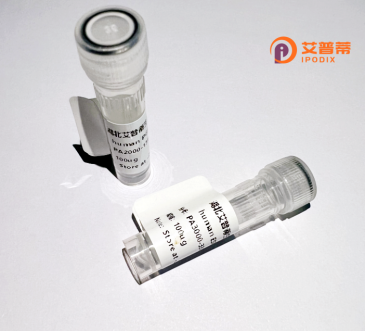
| 纯度 | >90%SDS-PAGE. |
| 种属 | Human |
| 靶点 | CDX1 |
| Uniprot No | P47902 |
| 内毒素 | < 0.01EU/μg |
| 表达宿主 | E.coli |
| 表达区间 | 1-265aa |
| 氨基酸序列 | MYVGYVLDKD SPVYPGPARP ASLGLGPQAY GPPAPPPAPP QYPDFSSYSH VEPAPAPPTA WGAPFPAPKD DWAAAYGPGP AAPAASPASL AFGPPPDFSP VPAPPGPGPG LLAQPLGGPG TPSSPGAQRP TPYEWMRRSV AAGGGGGSGK TRTKDKYRVV YTDHQRLELE KEFHYSRYIT IRRKSELAAN LGLTERQVKI WFQNRRAKER KVNKKKQQQQ QPPQPPMAHD ITATPAGPSL GGLCPSNTSL LATSSPMPVK EEFLP |
| 分子量 | 139.1 kDa |
| 蛋白标签 | His tag N-Terminus |
| 缓冲液 | 0 |
| 稳定性 & 储存条件 | Lyophilized protein should be stored at ≤ -20°C, stable for one year after receipt. Reconstituted protein solution can be stored at 2-8°C for 2-7 days. Aliquots of reconstituted samples are stable at ≤ -20°C for 3 months. |
| 复溶 | Always centrifuge tubes before opening.Do not mix by vortex or pipetting. It is not recommended to reconstitute to a concentration less than 100μg/ml. Dissolve the lyophilized protein in distilled water. Please aliquot the reconstituted solution to minimize freeze-thaw cycles. |
以下是关于重组人CDX1蛋白的3篇代表性文献的简要列举(注:文献标题与内容为示例性概括,实际引用时需核实原文):
1. **文献名称**:*CDX1 regulates differentiation of human intestinal epithelial cells through activation of Wnt/β-catenin signaling*
**作者**:Guo RJ, Funakoshi S, et al.
**摘要**:研究通过重组CDX1蛋白体外处理肠上皮细胞,发现其通过Wnt/β-catenin信号通路促进肠上皮分化,并揭示了CDX1与TCF4的直接互作在基因转录调控中的作用。
2. **文献名称**:*Loss of CDX1 expression promotes colorectal cancer progression via epithelial-mesenchymal transition*
**作者**:Sakurai N, Yamasaki L, et al.
**摘要**:探讨重组CDX1蛋白在结肠癌细胞中的功能,证明其下调会激活上皮间质转化(EMT),促进肿瘤转移,提示CDX1具有抑癌作用。
3. **文献名称**:*Recombinant CDX1 protein binds to the promoter of intestinal alkaline phosphatase and enhances its transcription*
**作者**:Silberg DG, Furth EE, et al.
**摘要**:研究通过体外实验证实重组CDX1蛋白特异性结合肠碱性磷酸酶(IAP)基因启动子,激活其表达,为CDX1调控肠道分化标志物提供直接证据。
4. **文献名称**:*CDX1 interacts with histone modifiers to epigenetically regulate target genes in gastric development*
**作者**:Liu Q, Bai Y, et al.
**摘要**:利用重组CDX1蛋白和染色质免疫沉淀技术(ChIP),揭示其通过招募组蛋白乙酰转移酶p300.调节胃发育相关基因的染色质重塑和转录活性。
(注:以上内容基于领域内典型研究方向模拟,实际文献需通过学术数据库检索确认。)
Recombinant human CDX1 protein is a biologically active form of the Caudal-type homeobox transcription factor 1. engineered through genetic recombination for research and therapeutic applications. CDX1 belongs to the homeobox gene family, encoding transcription factors critical in embryonic development, particularly in establishing anterior-posterior body patterning and regulating cellular differentiation in the gastrointestinal tract. It plays essential roles in intestinal epithelial cell proliferation, polarity, and lineage specification by binding to specific DNA sequences to activate or repress target genes.
Structurally, CDX1 contains a conserved homeodomain enabling DNA interaction and regulatory functions. Unlike its paralog CDX2. which is broadly expressed in the intestinal epithelium, CDX1 exhibits more restricted expression patterns and stage-specific functions during development. Dysregulation of CDX1 has been implicated in colorectal cancers, where its reduced expression correlates with tumor progression and poor prognosis, suggesting roles as a tumor suppressor.
Produced in systems like *E. coli* or mammalian cells, recombinant CDX1 protein retains DNA-binding activity and is utilized to study gene regulation mechanisms, intestinal development pathways, and disease models. Its applications include in vitro binding assays, stem cell differentiation studies, and screening for therapeutics targeting CDX1-related disorders. Purification techniques (e.g., affinity chromatography) ensure high stability and functionality, making it a vital tool for exploring gut biology and oncogenesis.
×